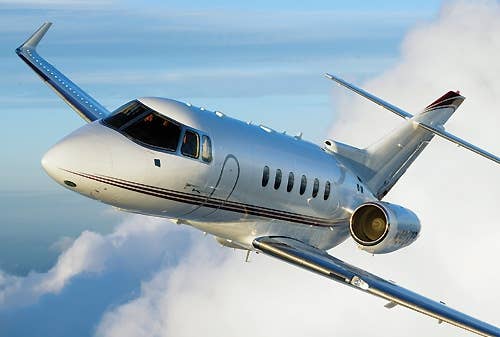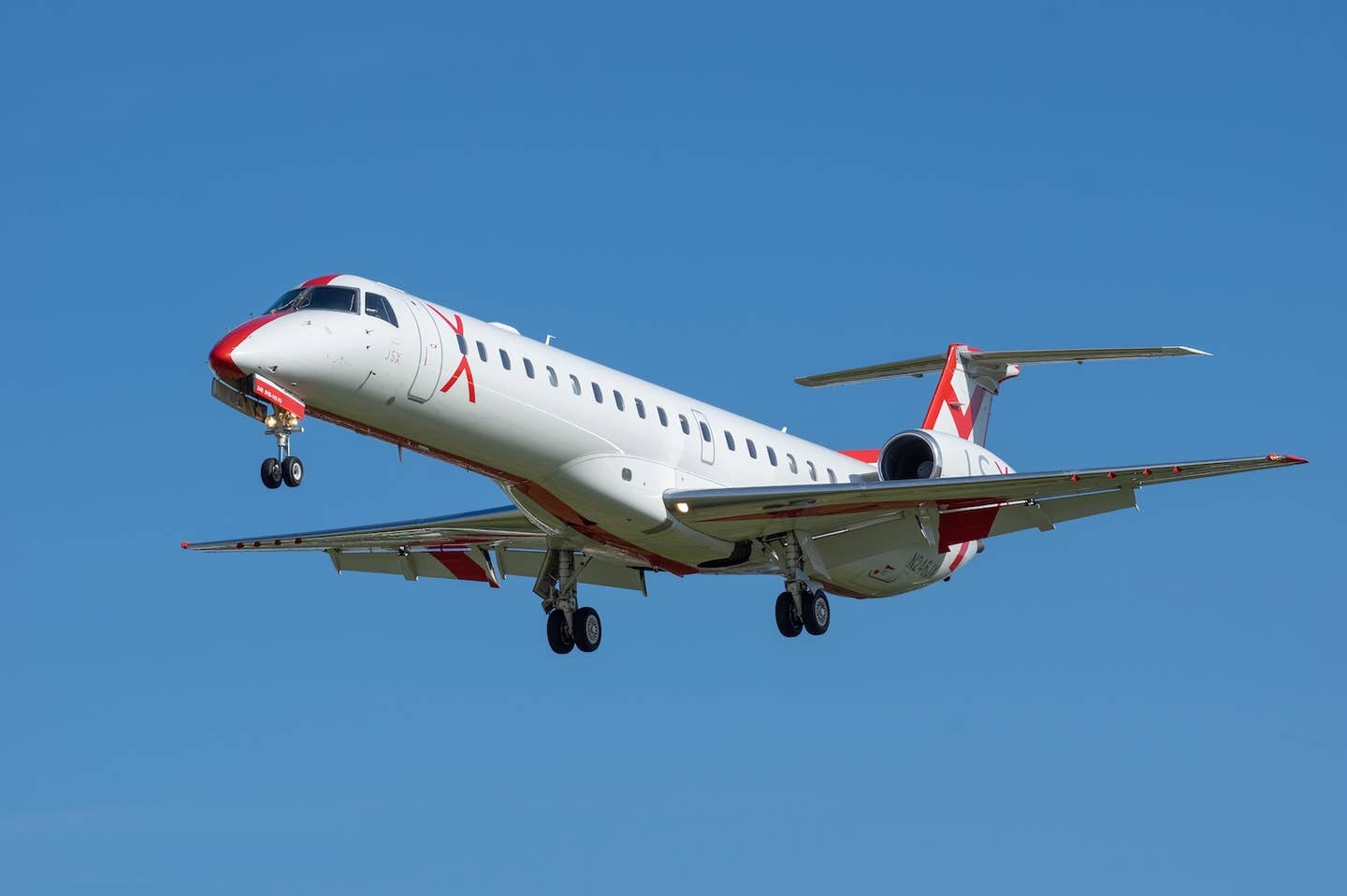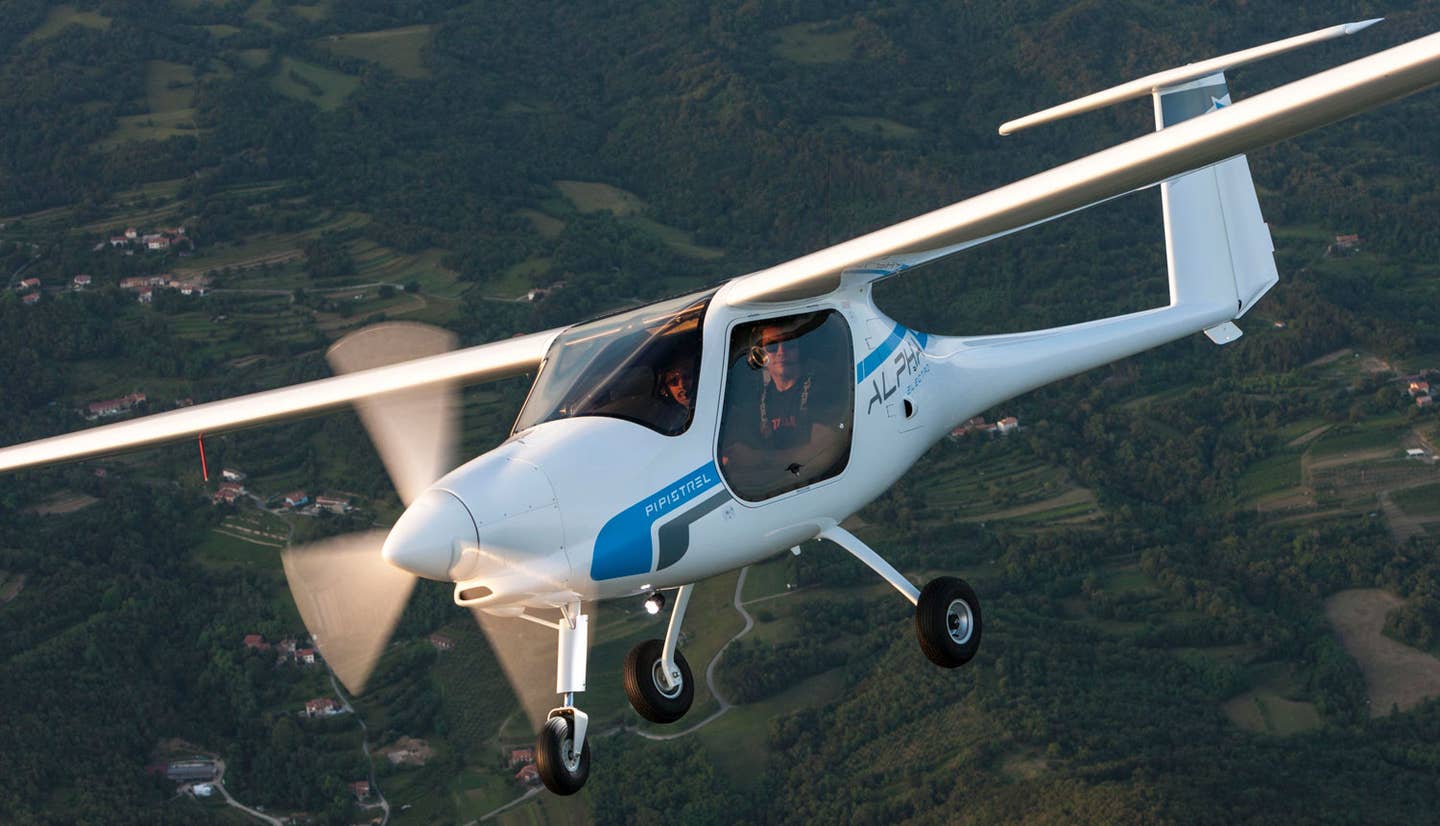
Hawker 900XP Beechcraft
Hawker Beechcraft is in the odd position of having two Hawker jets in its lineup that are many generations apart. The Hawker 4000 is a high-tech, super midsize jet with a carbon-fiber fuselage and the latest in system sophistication. The Hawker 900XP is the newest version of one of the very first business-jet designs. This Hawker has been in continuous production since 1962, longer than any other civilian jet. The only other airplane that comes close to such a long continuous-production run is the Boeing 737 that entered service in 1968.
Like the 737, the Hawker line has been stretched and had its wing modified, and is now powered by very advanced, efficient turbofan engines. The 900XP is little changed, except for the engines, from the previous 850XP, which grew winglets for better climb and improved range. New Honeywell TFE731-50R engines are so much better that all aspects of performance -- takeoff, climb, cruise speed, range -- are improved, with no addition of fuel capacity. And operating costs are reduced too.
Like other recently designed jets, the Hawker 4000 relies on multi-layered systems and sophisticated monitors to assure continued safety in the event of failures. But the 900XP is of a different era, when extra metal and manual backups for key systems governed design philosophy.
It's important to remember that the British were the first to have a viable civilian jet, the de Havilland Comet. The elegant Comet, with its engines buried in the wing roots, beat the Boeing 707 and Douglas DC-8 into airline service by several years in the 1950s.
But a series of in-flight airframe failures ended the Comet's lead as a jet airliner. The cause of the failures was eventually traced to metal fatigue, a phenomenon not well understood at the time. The higher levels of pressurization needed at jet altitudes, the different air loads and vibrations of jet flight, and a lack of understanding of how a fatigue crack could begin were all factors in the disasters. The entire global aviation industry learned important lessons from the Comet, but de Havilland learned the most.
Now put yourself in the shoes of the engineers at de Havilland who were tasked with designing a small jet intended to be used for personal transportation. The Hawker that we know today entered service as the Hawker-Siddeley 125, but the design originated at de Havilland before the companies merged under the Hawker name. The 125 number was a de Havilland design designation.
With the airframe failures of the Comet fresh in the minds of everyone at de Havilland, the level of conservatism when designing the 125 cannot be overstated. This airplane was designed to have an airframe that would never fail, and none has. It is approved for unpaved runways, even sod -- something very rare for a jet -- and Hawkers have survived both a ground-launched missile strike over Africa and a collision with a glider over the western United States. The crews of both airplanes landed without injury to passengers, though the captain of the Hawker that collided with the glider was injured when the glider's wing smashed into the nose of the jet.
When you look at a Hawker of any vintage, you can see this extra strength. The airplane weighs more than the minimum requirement, I'm sure, but there is enough useful load to fill the tanks and fill the seats, which is not the norm in other airplanes.
The systems are equally basic and robust. You don't need the hydraulics or electrics to carry on in the Hawker. There are system redundancy and backups, to be sure, but if your worst day happens, the Hawker will get you back to a runway.
The first several versions of the Hawker were powered by Rolls-Royce Viper turbojet engines. The Viper was a reliable but very loud and fuel-thirsty engine. And it didn't recover oil from all bearings in the engine, so oil consumption was high and copilots were tasked with pouring more oil in before every trip.
The airplane evolved into the 600, with a much longer cabin than the original, and with more fuel capacity for longer range. But the really big change came in 1976, when a refined version of the 600 was equipped with a Garrett -- now Honeywell -- TFE731 turbofan engines, and the airplane was renamed the 125-700. It was, along with the Learjet 35 and Falcon 10, one of the first applications of a turbofan in business jets. The 731 engine burned about half the fuel in cruise of the Viper, and range jumped accordingly.
In 1983 the wing was modified with a new shape and longer span, and the canopy was redesigned with wraparound windshields and a lower drag shape to create the 800. The Hawker had been a sales success, but it was the 800 that vaulted the airplane into the lead in the midsize-jet segment.
Though the Hawker traces its design roots back about 50 years, the Pro Line 21 avionics system, with its flat glass displays and full capability flight management systems, is on par with the most recently designed midsize jets. And the cabin materials and furnishings are top-notch, offering the comfort that has been key to keeping the airplane in production for so many decades.
There is a story, perhaps apocryphal, that when designing the original cabin cross section for the airplane, the de Havilland engineers went to the London clubs of the executives they expected to fly in the airplane and actually measured those gentlemen to size the cabin properly. It's a good story, maybe even true, but for whatever combination of research or good luck, the Hawker cabin came out right for a midsize jet. For all of the jet's other virtues, it is the comfort of the cabin that keeps selling the Hawker.
The cabin headroom is 5 feet, 9 inches, and the cabin is 6 feet wide at the widest point. The cabin floor is not interrupted by a wing spar carry-through. The cabin is typically fitted with five swiveling, reclining chairs and a three-place divan. There is a totally private and comfortably large potty in the aft cabin, and a roomy galley with cold storage and microwave forward. Over the past several years, Hawker Beechcraft has raised the quality of the cabin materials and fit and finish at its Little Rock, Arkansas, completion center to equal that of any jet. The workmanship is outstanding. And many seemingly small but important changes make the airplane more useful. For example, essentially every light inside and outside the cabin is now an LED of almost infinite life.
The one knock of the Hawker cabin by its competitors is that there is no external baggage compartment. There is a 33.4-cubic-foot baggage compartment on the right side of the cabin just as you enter the door. And in the 900XP, another baggage compartment just ahead of the lavatory in the aft cabin has been expanded to 16.1 cubic feet. Hawker crews become expert in packing these compartments, which do swallow an amazing amount of luggage, particularly the soft-side variety. The company's demo pilots challenge sales prospects to bring along all they want, and it is seldom that it doesn't all fit. And the contents of the luggage stay warm and pressurized in the cabin and are accessible by passengers in flight.
It is nearly impossible to tell the new 900XP from the 850XP on the ramp, especially once the engines are running. The fan blades on the new Dash 50R engines are swept, scimitar shape, while the fan blades on the 850XP engines have a conventional design. A true Hawker expert may be able to see a small change in the shape of the generator-cooling air scoop on the lower lip of the cowling, but that's it for external differences between the 850XP and 900XP.
The cockpit is also unchanged, since the 850XP already had a recent version of the Collins Pro Line 21 system. Collins is nearing certification of wide area augmentation system (WAAS) for the GPS receivers in the flight management systems (FMS), so the airplane will soon be approved to fly the ILS- style LPV approaches and operate with GPS as primary means of navigation.
Showing its British design roots, the Hawker cockpit retains several oddities. For example, a set of red levers aft of the throttles are labeled HP for high-pressure fuel cock and are used to introduce fuel for the start and then shut off fuel to shut down the engines. Another set of smaller levers are labeled LP for low-pressure shutoff cock and are used to stop fuel from entering the engine cowling in the event of a fire. The cockpit glareshield is also uniquely shaped and looks like, well, nothing but a Hawker.
The transition from the 850XP to the 900XP added about 90 pounds to the empty weight. Most of that is in the engines themselves, which are actually a diminutive version of the engines that power the big Falcon 900 trijets. The Dash 50R engines are rated at the same 4,660 pounds of thrust for takeoff as the Dash 5BR engines on the 850XP, but the new engines put out maximum power to a much higher-density altitude. For example, on a warm day at 5,000 feet elevation, the earlier engines could make only 3,800 pounds of thrust, but the new 50R puts out 3,970, a 4.5 percent improvement that does wonders to cut runway requirements.
The extra thrust at altitude allows the 900XP to climb directly to 41,000 feet after a maximum-weight takeoff, something the earlier engine allowed under only cool temperatures aloft. The quicker and higher climb adds up to increased fuel efficiency so maximum still-air IFR range on the same fuel has been stretched to just over 2,800 nm from 2,600 nm. And the 900XP cruises faster, so head winds are less damaging to range and all trips can be completed more quickly. The extra range now means the airplane has true coast-to-coast range when flying against 99 percent probability winds. The previous model could make the trip against 80 percent probability winds.
Despite its greater power and efficiency, the new 50R engine is more durable. The primary maintenance intervals have been stretched from 2,100 hours to 3,000 hours, and then again from 4,200 hours to 6,000 hours for the overhaul. That equals a 43 percent improvement in engine life, and it does great things to reduce the hourly cost of flying the 900XP.
To see this new capability in action, we loaded 6,100 pounds of fuel and a passenger into a brand-new 900XP, bringing takeoff weight to 22,760 pounds. It was hot at Beech Field in Wichita, Kansas, and as usual the winds were gusting, this time to 25 knots. Despite the high temperature, the required runway was 4,176 feet.
For years the Hawkers have had automatic power reserve (APR) that you arm for takeoff. If an engine fails during takeoff, the digital electronic engine computers (DEEC) that control the engines will feed fuel into the operating engine to increase power. The extra power of APR is built into the calculation for every takeoff and requires no action from the crew. The rudder bias system is so effective that if an engine fails, the pilot flying needs to add very little extra push on the rudder on the operating-engine side to keep the airplane flying straight. The DEEC behave like the full-authority digital engine computers (FADEC) now common on new jets but, like all things in this Hawker, are backed up by old-fashioned manual fuel controls instead of multiple-channel electronics.
I do love flying Hawkers. The Ipeco crew seats are comfortable and have dozens of adjustments; the cockpit is spacious; and the visibility out of the curved windshields is good. The big tiller wheel under your left hand is a simple hydraulic valve that meters pressure to the nose gear, making steering on the ground effortlessly smooth and easy. And the brakes are powerful but do not grab at taxi speed as many systems of more recent design tend to do.
For the takeoff we would make the go/no-go decision at 108 knots (V1) and then rotate at 116 knots indicated airspeed. If an engine failed, best single-engine climb angle (V2) was 126 knots. The drill is for the pilot flying to keep his left hand on the nose wheel tiller and right hand on the throttles to start the takeoff while the copilot positions the yoke as appropriate for any crosswind. When the rudder is effective, the pilot flying moves his left hand to the yoke to continue the takeoff.
Hawkers have only one unusual flying quality: At rotation, the yoke feels like it's connected to the elevator by rubber bands. You haul back on the yoke, and for an instant, nothing happens. And then the nose rotates, you release pressure and the airplane feels perfectly natural from then on.
Initial climb with the new engines was impressive, and even more so to note rates nearing 3,000 fpm out of 20,000 feet. Even climbing through 39,000 feet on the way to FL 400, the rate was near 2,000 fpm, not what anyone has come to expect from a Hawker. The DEEC control the engines perfectly, and you simply reduce power after takeoff until the word climb appears near the N1 fan-speed display. You do the same to set max cruise power, which in this case at FL 400 yielded a cruise speed of 440 knots with a fuel flow of 1,400 pounds per hour. The Pro Line 21 system showed a headwind of more than 100 knots, but with 5,000 pounds of fuel -- half the fuel capacity -- remaining, it computed that we could fly 900 nm into the teeth of the wind before getting to a very generous reserve fuel of 1,500 pounds.
I also tried the published long-range cruise speed, but I can't imagine ever using it unless you had a screaming tailwind and a very long way to go. At LR cruise of Mach .70, down from the Mach .766 at high speed, the true airspeed was 401 knots, and fuel flow was down to 1,170 pph.
Hawkers have a big handle that you use to modulate the speed-brake extension to any desired amount, so controlling descent rate is easy and smooth. Many other jets have speed brakes that are all or nothing. The big handle, when pulled up and over a gate, quickly extends the flaps to an extreme "lift dump" angle on the runway after landing for very effective deceleration and braking.
On the way back down to Wichita, there were some buildups around, and we could see them on the XM Weather radar page on the Pro Line 21. But the Hawker also has room in the nose for an 18-inch weather radar antenna, which is unusual for a midsize jet. The bigger the antenna, the greater the ability of the on-board Collins radar to see, and even see through, the first lines of weather.
The gusty wind and bumps were waiting for me back at Wichita, where I flew an ILS just for practice. The Hawker has a fairly small wing and thus a higher wing loading, so it is not tossed around a lot by turbulence, making it easier to stay on the approach course. The airplane is near the ideal landing attitude while on the glideslope, so very little flare is needed to make the landing. Despite the gusts, my landings worked out nice, which is another reason the airplane has been in production so long. An airplane that embarrasses its pilots gets a bad rap quickly.
However, I did prove to myself later back at Beech Field that it is very hard to bounce a Hawker. My excuse is that the threshold was displaced for workers near the runway and I flew a steeper angle than usual and cut the power while still too high. The result was a real thud, but the Hawker absorbed the hit; the mains stayed on the runway, and the rollout, as usual, was straight and true. It turned out to be an unintended short-field landing.
Times are tough for all airplane sales, but I'm optimistic about the 900XP because it does more for less, and that's a winning formula. Because of the efficiency of the new engines, the 900XP burns 4 percent less fuel per hour. The longer life of the engines means the engine renewal cost for each hour is 10 percent less. Add in the increased cruise speed and quicker climb of the 900XP compared to the 850XP, and you get an average cost per nautical mile that is 6 percent less for direct operating costs.
Is there an end in sight for the Hawker as it closes in on 50 years of continuous production? The 900XP proves to me that the answer is, "Not yet."

Sign-up for newsletters & special offers!
Get the latest FLYING stories & special offers delivered directly to your inbox






